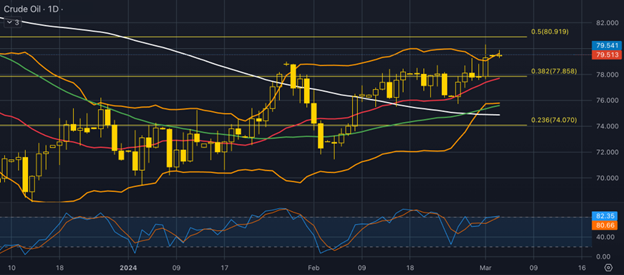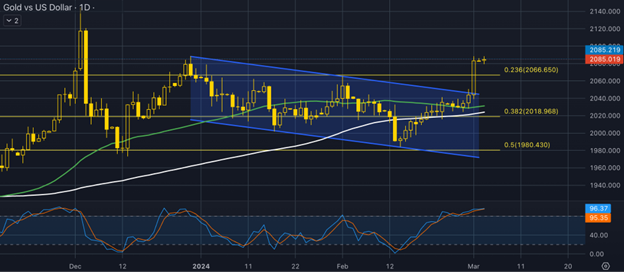Weekly data: Oil and Gold: Brief review before the NFP
The most important economic data for this week are: Tuesday: US Services PMI at 15:00 GMT for the month of February. The consensus is for a slight decrease of 0.4 points, reaching 53. This might be relatively bullish news for the dollar since it would mean that the services sector in the States is still […] The post Weekly data: Oil and Gold: Brief review before the NFP appeared first on LeapRate.


The most important economic data for this week are:
Tuesday:
- US Services PMI at 15:00 GMT for the month of February. The consensus is for a slight decrease of 0.4 points, reaching 53. This might be relatively bullish news for the dollar since it would mean that the services sector in the States is still expanding for the whole of 2024 so far.
Wednesday:
- Australian GDP growth rate at 12:30 A.M. GMT. The market consensus is for a decline in the figure to reach 1.4% against the previous 2.1%. If the consensus is confirmed, it could potentially create short-term losses on the Australian dollar against its pairs.
- US job openings are expected to be released at 15:00 GMT. The expectations are for a decline in the figure of around 131,000 jobs. That might not significantly affect the dollar since the data is for January. Also, all eyes will be focusing on the job report later this week for a more accurate conclusion on the labour market.
- Fed chair Testimony: Jerome Powell is expected to talk cautiously about lowering interest rates when he speaks to Congress on Wednesday and Thursday this week. He’ll likely stress the need for explicit proof that inflation is moving toward the Federal Reserve target of 2%. Some officials at the Federal Reserve suggest delaying rate cuts, but most people expect a change in the middle of the year, depending on how the economy is doing. This careful approach aligns with the central bank’s efforts to balance economic growth and stabilise prices.
Thursday:
- ECB Interest rate decision at 13:15 GMT. The market consensus is that the Central Bank of Europe will keep the rates stable at 4.5% at its meeting on the 7th. If there is a surprise rate hike, then the Euro might find support against other major currencies, while a cut might create some losses in the short term. Investors and traders are rather focused on the subsequent press conference following the release, which will focus on getting possible insights into the monetary policy steps ahead.
Friday:
- Canadian unemployment rate at 13:30 GMT. The market is expecting a slight increase in the figure of around 0.1% for February. That might have a minor negative effect on the loonie if the expectations are confirmed.
- US Job report at 13:30 GMT, where the non-farm payrolls and unemployment rate will be published. The expectation for the NFP is for a decline to reach 200,000 against the previous recording of 353,000. If these expectations are correct, the dollar could move down in various pairs in the aftermath of the release. On the other hand, the unemployment rate is expected to remain static at 3.7%.
USOIL, daily

OPEC+ extended production cuts, signalling a response to lower demand and increased output from other producers. This year, the slow but steady rise in oil prices has been influenced by tightening physical conditions, geopolitical tensions, and delayed expectations for Fed interest rate changes. The ongoing stalemate in ceasefire negotiations in the Middle East could keep oil prices steady or push them higher, while hedge funds’ short positions in the oil market have reached their lowest point since October.
On the technical side, the price is trading in a somewhat aggressive bullish trend and is currently testing the inside resistance area it reacted in mid and late November 2023. Also, it is trading exactly on the upper band of the Bollinger bands, indicating that volatility is fuelled up while the stochastic oscillator is in the extreme overbought levels. Both these indicators point to the scenario of a possible correction to the downside in the near short term. If this becomes a reality, then the first area of potential support could be found around the $78 price area, which is the support level of the 38.2% of the daily Fibonacci retracement level as well as the 20-day moving average. On the other hand, if the bulls prove to be stronger than the bears and the bullish momentum keeps at its current pace, then the resistance level of $81 might be the first target since it is made up of the 50% of the daily Fibonacci retracement as well as an area of price reaction in early November.
_____________________________________________________________________________________________
Don’t miss out the latest news, subscribe to LeapRate’s newsletter
_____________________________________________________________________________________________
Gold-dollar, daily

The gold price is currently near a two-month high due to subdued USD demand, a softer risk tone, and upcoming US data/events that could provide a fresh boost. The recent disappointing US macro data, like the decline in the second estimate of the GDP growth and lower-than-expected manufacturing PMI, as well as less-hawkish remarks by Federal Reserve officials, have weakened the US dollar, contributing to a supportive environment for the gold price. The momentum created for gold, on the other hand, has been unexpected, making it a somewhat risky choice for short-term traders, but let’s check the technical image as well to get a better understanding of the move.
From the technical point of view, the gold price has broken above the bearish trading channel in effect since late 2023 while also breaking above the resistance of the 23.6% of the daily Fibonacci retracement level. The 50-day moving average still trades above the 100-day moving average, further validating the bullish momentum, while the stochastic oscillator has been pushed to extreme overbought levels. If the Dollar Index (DXY) continues to decline in the coming sessions, it would not be strange to see a retest of the all-time high level in gold prices near the $2,120 price area. In the event, however, of a correction, then the first possible area of support might be found around $2,020, which consists of the 38.2% of the Fibonacci retracement level, the dynamic area between the 50 and 100-day moving averages as well as the psychological support of the round number.
Disclaimer: the opinions in this article are personal to the writer and do not reflect those of Exness or Leap Rate.
The post Weekly data: Oil and Gold: Brief review before the NFP appeared first on LeapRate.







